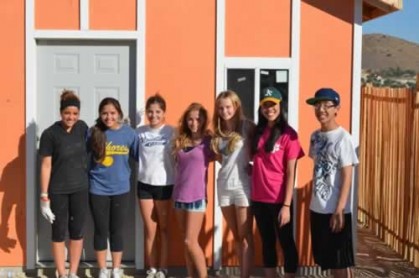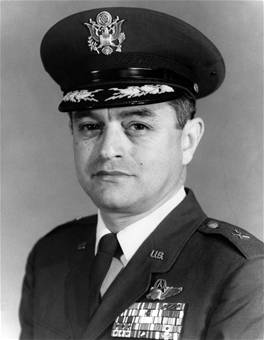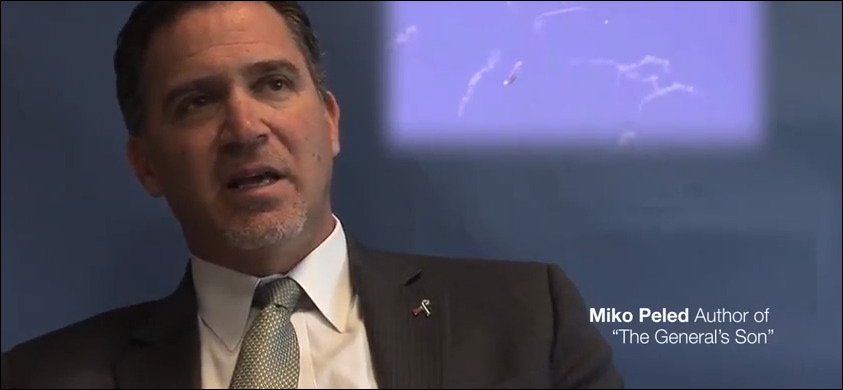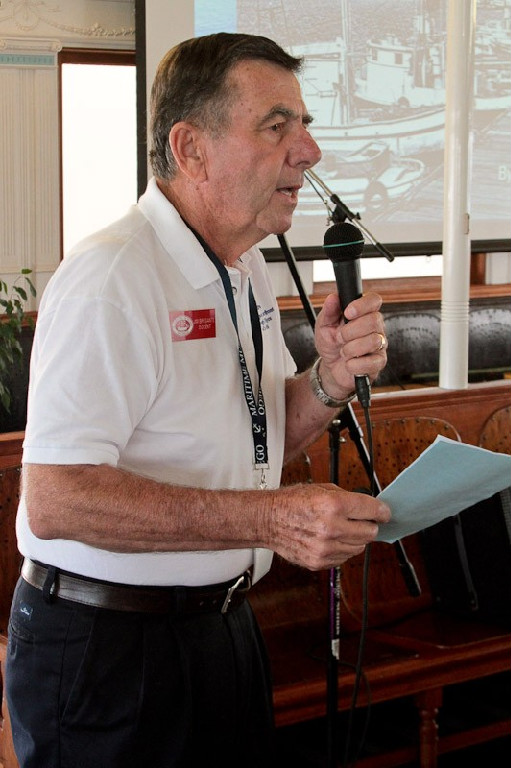
Brigadier General Robert L. “Bob” Cardenas, USAF (retired)Test Pilot, Combat Leader in both Bombers and Fighters as well as Commander of the Air Force Special Operations Force. He has flown over 60 different aircraft in his career. He was shot down and eluded capture, making it to Switzerland, where he was repatriated to England. Awarded the Distinguished Flying Cross during his service in WWII. He flew the B 29 that dropped Chuck Yaeger when he broke the sound barrier in the X-1. Also piloted the experimental flying wing down Pennsylvania Ave. in Washington D.C. at the request of President Truman.
General Cardenas began his military career as a Private in the Army Cost Artillery, then became a pilot as a Cadet in the Army Air Corps. He was commissioned a 2nd Lt. in July 1941 and in 1942 was sent to 29 Palms, CA to establish an Army Air Corps Glider School.
In 1944 he flew combat missions in B-24 Liberators in the skies over Germany, He was  shot down on his 20th mission but was not captured. He escaped into Switzerland and then into France prior to D Day. He was later flown out back to England and to a rehabilitation center in the US. He became a test pilot after his graduation in 1945 from the Flight Performance School at Vandalia, Ohio.
shot down on his 20th mission but was not captured. He escaped into Switzerland and then into France prior to D Day. He was later flown out back to England and to a rehabilitation center in the US. He became a test pilot after his graduation in 1945 from the Flight Performance School at Vandalia, Ohio.
He participated in the flight test evaluation of the German jet fighter ME-262 and the Arado 234 bomber. In 1947 Cardenas was a key member of the X-1 supersonic project.
Major Cardenas was the Officer In Charge Of Operations and command pilot of the B-29 that launched Captain Charles Yeager into the realm of supersonic flight.
In 1948, he was assigned as Officer in charge of Flight Test Division projects at Muroc AB and as Chief Air Force test pilot on the YB-49 flying wing project. After completion of the Performance Phase II tests he checked out Captain Glen Edwards in the YB-49 on May 20 & 21st. He then received orders to USC for completion of his Aeronautical Engineering degree. He was ordered back 15 days later, after the crash of the YB-49 and loss of the crew, in order to complete the Stability & Control Phase in the remaining YB-49 aircraft.In November 1948 he gave a final briefing to a Board of General Officers at Patterson AFB on the results of the test program. In January 1949 he was ordered to fly the YB-49 from Muroc AB to Andrews AFB in Washington for President Truman’s Air Show. The transcontinental non-stop flight set a record time of 4 hours and 5 minutes.
During the Korean War, Cardenas was at Wright Field and Edwards AFB testing new jet fighters and bombers. He was then Commander of the 51st Fighter Interceptor Wing at Naha AB on Okinawa after completion of Air War College. On his return to the States he was assigned to the Pentagon as Chief of the Aircraft and Missiles Program Division.
From the Pentagon, he was assigned as Chief of the Special Operations Division at US Strike Command Headquarters in Tampa, Florida. In 1962 he led a joint Army & Air Force Special Force into the Kashmir, India for the purpose of evaluating and improving high altitude resupply drops in the Himalayan Mountains. He used these techniques to equip forces and prevented an incursion of Chinese through the Himalayas linking into East Pakistan.
He was then sent back to Okinawa as Commander of the 18th Tactical Fighter Wing at Kadena AFB. After the Gulf of Tonkin crisis he flew F-105 combat missions from Korat, Thailand over North Vietnam. He returned to the US to command the 835th Air Division at McConnell AFB, training F-105 crews for combat in Vietnam.
He was promoted to Brigadier General in 1968 and placed in Command of the Air Force Special  Operations Force at Eglin & Hurlburt AFB, Florida. On October 12, 2002 his contributions to the development of Special Forces was recognized by induction into the Air Commando Hall of Fame.
Operations Force at Eglin & Hurlburt AFB, Florida. On October 12, 2002 his contributions to the development of Special Forces was recognized by induction into the Air Commando Hall of Fame.
He went on to be assigned in Europe as Vice Commander of the 16th Air Force in Spain. It was there that he had the dubious honor of negotiating with Muammar Gadhafi the withdrawal of US forces from Wheelus AFB in Libya.
As the US Deputy to Live Oak in Belgium his responsibility to SACEUR was to maintain open corridors to Berlin by calling the Soviets bluff to block travel to Berlin by land, air or rail. Prior to his retirement in June 1973, General Cardenas served as the Chief of the JL Division of the Joint Strategic Target Planning Staff (JSTPS) where he was responsible for the development of the Joint Stategic Target List of the US nuclear War Plan (SIOP).
Cardenas has been honored by the Distinguished Service Medal, Legion of Merit with Oak Leaf Cluster, Distinguished Flying Cross, Purple Heart, Meritorious Service Medal, Air Medal with four Oak Leaf Clusters, Joint Service Commendation Medal, Air Force Commendation Medal with Oak Leaf Cluster and the Presidential Citation. Foreign decorations include the Spanish Grand Legion of Aeronautical Merit with Sash & Dagger.
 From 1973 until 1983, Cardenas worked as an Executive in private industry. In 1983 he was appointed to the White House as the California coordinator for President Reagan’s Southwest Boarder Economic Action Group. He resigned in 1985 and accepted an appointment by Governor Dukemejian as Chairman of the Juvenile Justice and Delinquency Prevention Advisory Group as well as a member of the California Council of Criminal Justice.
From 1973 until 1983, Cardenas worked as an Executive in private industry. In 1983 he was appointed to the White House as the California coordinator for President Reagan’s Southwest Boarder Economic Action Group. He resigned in 1985 and accepted an appointment by Governor Dukemejian as Chairman of the Juvenile Justice and Delinquency Prevention Advisory Group as well as a member of the California Council of Criminal Justice.
In 1987 the Governor appointed the General to the California Veterans Board where he was later elected to be Chairman of the Board that is the policymaking body for the California Department of Veterans Affairs. He left in 1993 to serve as Chairman of the San Diego United Veterans Council and as a Director on the Board of the Veterans Memorial Center & Museum.
On April 15, 1993 the University of New Mexico, College of Engineering, honored him for his outstanding Professional contributions and leadership. The USAF Test Pilot School at Edwards AFB honored the General on December 10, 1994 as a “Distinguished Alumnus” and on September 1995 he was inducted into the “Aerospace Walk of Honor” at Lancaster, California.
The Sigma Chi fraternity awarded him the “Significant Sig” medal during their 1995 National Convention in Albuquerque, New Mexico. Currently he serves as a member of th e San Diego Mayor’s Veteran Advisory Board, Chairman of the Veterans Memorial Museum & Center as well as a Trustee of the Flight Test Historical Foundation at Edwards AFB.
e San Diego Mayor’s Veteran Advisory Board, Chairman of the Veterans Memorial Museum & Center as well as a Trustee of the Flight Test Historical Foundation at Edwards AFB.
Gen. Cardenas reports when he received Sigma Chi’s award, it was significant to him as this is a prestigious and long time standing institution; as they celebrated their 150th anniversary in June 2005. The ceremony was held near it’s birthplace, in Cincinnati, Ohio.
To celebrate this milestone of 150 years of existence, they selected 150 members of Sigma Chi to be members of the Significant Sigma Chi Hall of Fame”. He says he was extremely humbled to have been selected, and more so when he saw who the other 149 were.
He was recently appointed By the VA Secretary Anthony Principi to the VA Memorials and Cemetery Committee in Washington. It is a statutory Advisory Committee that meets in Washington and other locations.
General Cardenas lives at home with his wife Gladys and their children and grandchildren in San Diego, California.




 shot down on his 20th mission but was not captured. He escaped into Switzerland and then into France prior to D Day. He was later flown out back to England and to a rehabilitation center in the US. He became a test pilot after his graduation in 1945 from the Flight Performance School at Vandalia, Ohio.
shot down on his 20th mission but was not captured. He escaped into Switzerland and then into France prior to D Day. He was later flown out back to England and to a rehabilitation center in the US. He became a test pilot after his graduation in 1945 from the Flight Performance School at Vandalia, Ohio. Operations Force at Eglin & Hurlburt AFB, Florida. On October 12, 2002 his contributions to the development of Special Forces was recognized by induction into the Air Commando Hall of Fame.
Operations Force at Eglin & Hurlburt AFB, Florida. On October 12, 2002 his contributions to the development of Special Forces was recognized by induction into the Air Commando Hall of Fame. From 1973 until 1983, Cardenas worked as an Executive in private industry. In 1983 he was appointed to the White House as the California coordinator for President Reagan’s Southwest Boarder Economic Action Group. He resigned in 1985 and accepted an appointment by Governor Dukemejian as Chairman of the Juvenile Justice and Delinquency Prevention Advisory Group as well as a member of the California Council of Criminal Justice.
From 1973 until 1983, Cardenas worked as an Executive in private industry. In 1983 he was appointed to the White House as the California coordinator for President Reagan’s Southwest Boarder Economic Action Group. He resigned in 1985 and accepted an appointment by Governor Dukemejian as Chairman of the Juvenile Justice and Delinquency Prevention Advisory Group as well as a member of the California Council of Criminal Justice. e San Diego Mayor’s Veteran Advisory Board, Chairman of the Veterans Memorial Museum & Center as well as a Trustee of the Flight Test Historical Foundation at Edwards AFB.
e San Diego Mayor’s Veteran Advisory Board, Chairman of the Veterans Memorial Museum & Center as well as a Trustee of the Flight Test Historical Foundation at Edwards AFB.

















